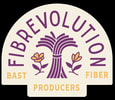Catalyzing a Regenerative West Coast Fiber SystemFibershed has developed an initiative to coordinate and implement a manufacturing strategy that will regionalize the production of textiles and contribute to climate solutions. The Regional Fiber Manufacturing Initiative will:
Fibrevolution co-founders Shannon Welsh and Angela Wartes-Kahl have both been asked to serve on the Board for the RFMI. Angela will serve on the Material Production committee and Shannon will serve on the Manufacturing committee, with the Stewardship committee and Chiefs of Staff as the backbone of the Initiative. You can learn more and follow the work of the RFMI here:
1 Comment
YarnStories - A podcast telling the tales behind our favorite fibers
"Fibrevolution’s mission is to bring flax and linen production back to the state of Oregon (and really the United States). We’ll talk a little today about what happened to the industry there and what challenges Shannon and Angela face trying to bring it back." Listen to Podcast here: Episode 215: Fibrevolution with Shannon Welsh "Can these Oregon producers bring linen back to the U.S.?" View video - Weaving a New Future For U.S. Fashion Economy GIST yarn & fiber / "Contextualizing Textiles" for the GIST Weave Podcast
Listen to Episode 45: Regenerative Regional Flax Production with Angela Wartes-Kahl of Fibrevolution Eugene and Felix McConville's family have been involved in the scutching of flax for linen production for countless years. Together these brothers work to keep this century's old craft alive for future generations by offering tours of their flax museum and water powered flax scutch mill near Dromore in Co Down, Northern Ireland. This is the last water powered scutch mill still working today. We had the pleasure of visiting with Eugene and Felix McConville and got a first hand look at this mighty mill in action. Bringing linen production back to the Pacific Northwest!For 3 years Fibrevolution has been immersed in all things flax and linen. We are growing an industry invested in the health of seeds, soil, workers, and wearers by reviving linen production in the Pacific Northwest. As of August 2018, we finished hand harvesting our second organically grown flax fiber crop. In order to scale up and truly grow a linen economy in Oregon, we are seeking the funds to purchase specialized harvesting equipment through an Indiegogo crowdfund campaign, which will go live for funding on Tuesday, Sept. 4, 2018. Please follow link to sign up to get the latest updates and find out when we launch! - www.indiegogo.com/projects/american-linen-revival/coming_soon/x/19027593 Help Us Bring Linen Back to the Pacific Northwest!
From fields of golden flax to linen fiber...
Oregon's Willamette Valley has a storied history with linen fiber, and a bright future ahead. A follow-up to the enthusiastic response of 2018 Design Week's panel discussion, "Connecting Threads: Rebuilding our Domestic Apparel System", Shannon Welsh and Angela Wartes-Kahl of Fibrevolution, present a primer about this incredible bast fiber. They will talk about some of its close relatives, its evolution worldwide and in our region, as well where this revived industry is heading domestically and what steps Fibrevolution is taking to move it forward. A fascinating and relevant topic for anyone interested in local agriculture, organic farming, textile manufacturing, land use, apparel, sustainable building materials, craft, design, local industry. This event is free and and seats are limited. Please RSVP below to ensure your spot. THURSDAY, AUGUST 30TH 5:30PM - 8:00PM THE CLEANERS 403 SW 10th Ave, Portland, OR 97205 SEATING IS LIMITED. PLEASE RSVP TO ATTEND. Refreshments provided, come thirsty! THANK YOU TO OUR LOCAL SPONSORS: ACE HOTEL PORTLAND // BRIDGEPORT BREWING // COOPER MOUNTAIN VINEYARDS // MONTINORE ESTATE VINEYARDS // STEVEN SMITH TEAS // THE SUTTLE LODGE & BOATHOUSE Here's a look at the history of fiber flax in Oregon and the process in which fiber flax goes through to produce linen. Growing and processing flax for oil and textiles played an important role in the economy of the Mid-Willamette Valley. The Willamette Heritage Center Collections has over 200 items related to the history of flax and linen production in the Pacific Northwest. Kylie Pine, the Curator and Collections Manager for the Willamette Heritage Center, has graciously digitized multiple historical pamphlets and magazine articles related to the flax industry in Oregon. We are thankful to Kylie, and the Willamette Heritage Center, for their collaboration on our flax to linen research, as well as for sharing all of this wonderful documentation with the community.
Please click here to view - Flax and Linen Collections - Enjoy! |
AuthorWrite something about yourself. No need to be fancy, just an overview. Archives
August 2023
Categories |
STRATEGIC ECONOMIC DEVELOPMENT CORPORATION Member |
